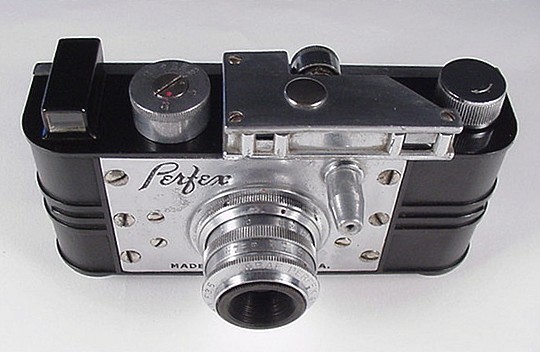
Perfex Speed Candid Camera

There are those who have called the Perfex Speed Candid the world's ugliest camera. OK, that may be. There are those who say it is inner beauty that's truly important. OK, I won't argue with that. With these precepts in mind I began my search for the Speed Candid's true inner beauty. Along the way I gained a fondness for this great American albatross. And surprisingly, I discovered a novel feature that as far as I know appeared for the first time on the Speed Candid.
Actually, this new feature is visible in the photo above. I'll discuss this bit of ingenuity soon. Meanwhile, here's a hint. It is not that bullet shaped object protruding from the front of the camera opposite the Perfex name. That object is a difficult to find accessory cable release adaptor. It screws into the collar that surrounds the shutter release button.
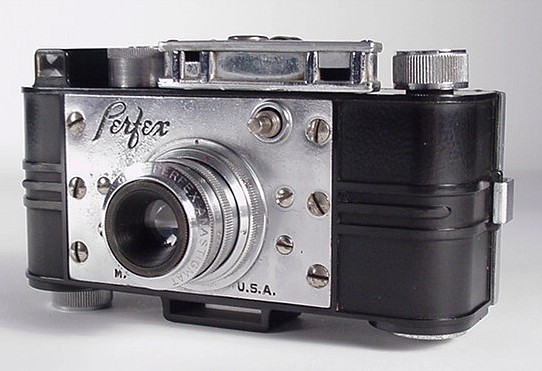
The Perfex Speed Candid was manufactured by the Candid Camera Corporation of Chicago, Illinois USA during 1938 - 39. This was Candid Camera Corp.'s first camera and it was not popular with the buying public. The serial number on this example is 2398. I would like to determine the quantity manufactured, so if you have one of these cameras, I would appreciate an email giving the serial number. Because production was low, Speed Candids are not easy to find.
The camera is constructed of bakelite and metal. Although this is a full-frame 35mm camera, it is large, bulky, awkward and heavy. The bakelite on this camera is in excellent condition, which is surprising. The polished chrome plating however was not very durable. I doubt a "mint" condition Speed Candid can be found, but if so, I'd like to hear about it.
The shutter release button can now be seen on the camera front where the cable release adaptor was previously located. Also notice a squat rectangular window on the camera bottom. The Speed Candid had an extinction exposure meter, and this is where it was located. The extinction meter consisted of a strip of film with numbers of varying densities. To use the meter, aim the camera at the subject. Look at the strip and locate the first number that is visible given the lighting conditions. Transfer the number to a calculator dial mounted on the camera back (next photo). The calculator indicates the correct combinations of aperture and shutter speed to use. Extinction strips were the most fragile part of a Speed Candid. Over the years, they would just pop out of their frame and become lost.
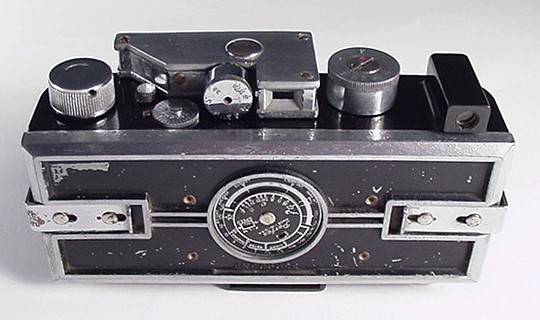
This view reveals most of the Speed Candid's operational details. On the camera top at the far left is the film wind knob with its somewhat unusual left-handed orientation. To its right are the film advance release button and the exposure counter wheel. Next is the rangefinder housing. What looks like a round cylinder protruding from the back of the housing is the focusing knob. The round disk on top of the housing allows a repair person access to the rangefinder infinity adjustment. That very crude looking rectangular window on the right end of the housing is the rangefinder eyepiece. The large round cylinder to the right of the housing serves two functions. It is the shutter speed setting control and the shutter winding knob. To its right is the eye-level optical viewfinder.
Here is my impression of all this. The film wind is not coupled to the shutter wind. So, for each exposure there are two knobs to wind. Also, what I find really awkward, is the shutter wind is not ratcheted. The knob needs to be turned about 270 degrees without letting go of your grip, otherwise the knob snaps back. And to make matters worse, you would think such a large knob would be easy to grip, but with the range and viewfinder housings in the way, it's a challenge to wind the shutter.
The split-image rangefinder is not coupled to the lens. To focus the camera, rotate the rangefinder's focusing knob, aligning the split images. The knob and the camera lens are both marked in distances of feet. Now set the lens focusing ring to match the distance indicated by the rangefinder knob.
Two other things to notice are the extinction meter exposure calculator, in the center of the removable back, and the two back clasps at each side. To load film, the camera back is completely removed from the body.
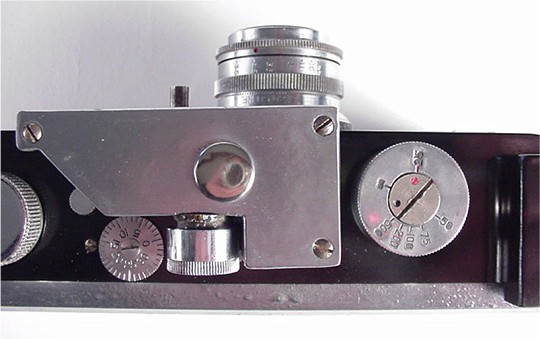
One surprising detail and a few interesting observations can be drawn from the photo above. Notice that the front edge of the rangefinder housing is not at all square with the camera body. The film counter wheel can now be clearly seen. There is a screw head to its left, at 9 o'clock. That screw head serves no other function than to act as the frame counter index mark.
But the big surprise is revealed by the shutter speed setting knob. The Speed Candid shutter has a lift-and-set rotating speed dial, as did other early focal plane shutters. With a rotating dial, it was necessary to wind the shutter before setting the desired speed opposite an indicator (usually a black dot). Because of the degree of rotation, after the shutter was fired, the black dot was no longer aligned with the chosen speed. So the rule was, wind then set. The same was true with the Speed Candid. But the Speed Candid designer's brilliant innovation was to engrave two dots on the speed dial. After winding, the speed was set against the black dot. But before winding it could be set against the red dot! Notice above, that 25 is opposite the red dot. This tells us that the shutter is unwound, and the shutter had been fired at 1/25 second. By the way, available shutter speeds were 1/25 to 1/500 second, plus bulb.
Admittedly, the red dot, or the ability to set the shutter before or after exposure is not a huge invention, but I think it is worthy of note. On an otherwise clumsy, awkward, barely usable camera, here is a useful innovation.

I'd long thought the Speed Candid was the first and only rotating-dial focal plane shutter camera to indicate shutter speed before or after shutter cocking. I've recently discovered that early Clarus MS-35 cameras also implemented this feature. The Clarus, introduced eight years after the Speed Candid, is engraved with red and black arrows that perform the same function. Notice in the image of the Clarus shutter speed control, the red arrow points to 200. This tells us that the shutter is not cocked and that it is set for 1/200 second. After cocking, the 200 will appear opposite the black arrow. The black arrow is located between the letters Y and S, at 8 o'clock on the camera name plate.
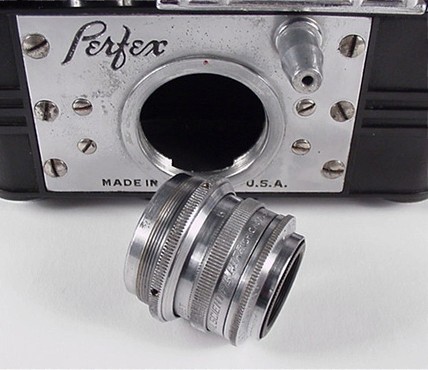
This image shows the interchangeable lens and camera lens mount, a proprietary screw-thread. The lens was made by General Scientific Instrument Corporation of Chicago. It is a 2 inch f/3.5 Graf Perfex Anastigmat, in a heavy chrome-plated mount with stops to f/22 and focus to 3 feet. The camera's rangefinder by the way, focuses to 3 1/2 feet. I guess that last 1/2 foot is not all that important. Lens focus is not coupled to the rangefinder.
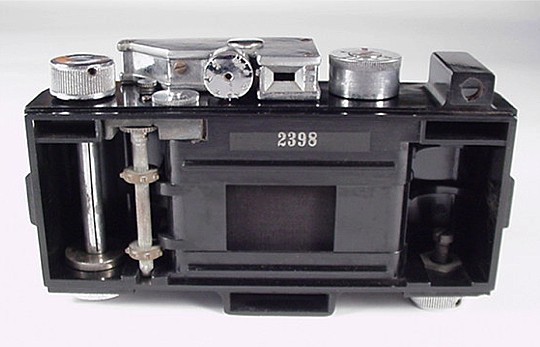
The cloth focal plane shutter curtain is still in good condition and operates at all speeds. The Perfex Speed Candid owns the distinction of being the first focal plane shutter 35mm camera to have been manufactured in the United States. The serial number (2398) is located above the film gate.
The camera interior reveals a wind mechanism remarkably similar to that of the Argus model A and C cameras. The Argus A, introduced in 1936, and the Argus C, introduced in 1938, were manufactured by International Research Corp., later known as Argus, Inc. of Ann Arbor, Michigan and Chicago, Illinois.
The following design elements are surprisingly similar: left-hand film-wind, right bottom rewind, film sprocket, wind mechanism casting, take-up spool, film counter dial and film wind release. The parts are not interchangeable, because the dimensions are different. I first noticed this similarity as I worked on writing this page. Now I wonder if Argus constructed part of the Speed Candid camera? Some parts, such as the rangefinder unit are too crude for me to think they were built by Argus. It may also be that Argus licensed its designs to Candid Camera Corporation.

|
Page created February 4, 2002;
updated December 20, 2020 |